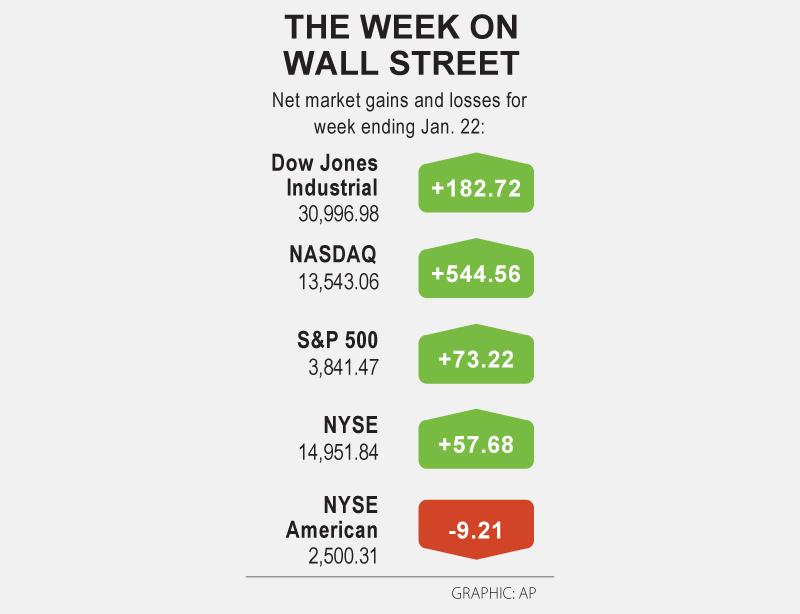The Dow Jones Industrial Average and S&P 500 ended modestly lower on Friday, dragged down by losses in blue-chip technology stalwarts Intel Corp and IBM Corp following their quarterly results, as hopes for a full economic reopening in the coming months waned.
IBM slumped 9.91 percent and was the top drag on the Dow after it missed estimates for quarterly revenue, hurt by a rare sales decline in its software unit.
Intel slipped 9.29 percent as new chief executive officer Pat Gelsinger’s post-earnings comments suggested the lack of a strong embrace of outsourcing.

However, losses in the tech sector were offset by gains from Microsoft Corp and Apple Inc, keeping the declines on the main US stock indices in check and lifting the NASDAQ Composite slightly.
Energy and financials were the worst performers among the 11 S&P sectors, while the defensive utilities and real-estate groups advanced.
“Any delay or setback in the reopening theme is probably going to be a headwind for the energy sector,” said Andrew Mies, chief investment officer at 6 Meridien in Wichita, Kansas.
“[But] the market is telling you that its confidence in the cyclicals are diminished right now,” he said.
The S&P 500 and the NASDAQ pared some losses shortly after the opening bell as data showed US manufacturing activity surprisingly surged to its highest level in more than 13.5 years early this month, in contrast to a disappointing result in the purchasing manager data in Europe earlier.
The Dow Jones Industrial Average on Friday fell 179.03 points, or 0.57 percent, to 30,996.98, the S&P 500 lost 11.6 points, or 0.30 percent, to 3,841.47 and the NASDAQ Composite added 12.15 points, or 0.09 percent, to 13,543.06.
Volume on US exchanges was 12.79 billion shares, compared with the 12.68 billion average for the full session over the past 20 trading days.
Despite the weakness, the three major indices notched weekly gains, with the tech-heavy NASDAQ tracking for its best weekly performance since Nov. 6 as investors piled into Alphabet Inc, Apple Inc and Amazon.com Inc in anticipation of their earnings reports in the coming weeks.
For the week, the S&P rose 1.94 percent, the Dow added 0.59 percent and the NASDAQ unofficially gained 4.19 percent.
With stock valuations nearing levels not seen since the Dotcom era, some market participants said new COVID-19 variants and hiccups in vaccine rollouts pose near-term risks.
US President Joe Biden on Friday said that the US economic crisis was deepening and that the government needs to take major action now to help struggling Americans.
“The absolute assurance that investors felt a week ago ...some of that is starting to fade out of the market.” Mies said, regarding the decline in the virus and the reopening of the economy.
The US Senate Finance Committee unanimously approved Janet Yellen’s nomination as the first female secretary of the US department of the treasury, indicating that she would easily win full Senate approval.
Declining issues outnumbered advancing ones on the New York Stock Exchange by a 1.00-to-1 ratio; on NASDAQ, a 1.53-to-1 ratio favored advancers.
The S&P 500 posted 16 new 52-week highs and no new lows; the NASDAQ Composite recorded 189 new highs and seven new lows.

DIVIDED VIEWS: Although the Fed agreed on holding rates steady, some officials see no rate cuts for this year, while 10 policymakers foresee two or more cuts There are a lot of unknowns about the outlook for the economy and interest rates, but US Federal Reserve Chair Jerome Powell signaled at least one thing seems certain: Higher prices are coming. Fed policymakers voted unanimously to hold interest rates steady at a range of 4.25 percent to 4.50 percent for a fourth straight meeting on Wednesday, as they await clarity on whether tariffs would leave a one-time or more lasting mark on inflation. Powell said it is still unclear how much of the bill would fall on the shoulders of consumers, but he expects to learn more about tariffs

NOT JUSTIFIED: The bank’s governor said there would only be a rate cut if inflation falls below 1.5% and economic conditions deteriorate, which have not been detected The central bank yesterday kept its key interest rates unchanged for a fifth consecutive quarter, aligning with market expectations, while slightly lowering its inflation outlook amid signs of cooling price pressures. The move came after the US Federal Reserve held rates steady overnight, despite pressure from US President Donald Trump to cut borrowing costs. Central bank board members unanimously voted to maintain the discount rate at 2 percent, the secured loan rate at 2.375 percent and the overnight lending rate at 4.25 percent. “We consider the policy decision appropriate, although it suggests tightening leaning after factoring in slackening inflation and stable GDP growth,”

Greek tourism student Katerina quit within a month of starting work at a five-star hotel in Halkidiki, one of the country’s top destinations, because she said conditions were so dire. Beyond the bad pay, the 22-year-old said that her working and living conditions were “miserable and unacceptable.” Millions holiday in Greece every year, but its vital tourism industry is finding it harder and harder to recruit Greeks to look after them. “I was asked to work in any department of the hotel where there was a need, from service to cleaning,” said Katerina, a tourism and marketing student, who would

i Gasoline and diesel prices at fuel stations are this week to rise NT$0.1 per liter, as tensions in the Middle East pushed crude oil prices higher last week, CPC Corp, Taiwan (台灣中油) and Formosa Petrochemical Corp (台塑石化) said yesterday. International crude oil prices last week rose for the third consecutive week due to an escalating conflict between Israel and Iran, as the market is concerned that the situation in the Middle East might affect crude oil supply, CPC and Formosa said in separate statements. Front-month Brent crude oil futures — the international oil benchmark — rose 3.75 percent to settle at US$77.01